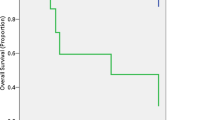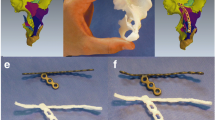Abstract
Purpose
Acetabular fractures typically occur in high energy trauma. Understanding of the various contributing biomechanical factors and trauma mechanisms is still limited. While several investigations figured out what role femoral position during impact plays in distinct fracture patterns, no data exists on the influence of acetabular version on the fracture type. Our study was carried out to clarify this issue.
Methods
Radiological data sets of 192 patients (145 male, 47 female, age 14–90 years) sustaining acetabular fractures were assessed retrospectively. The crossover ratio of the crossover sign and presence or absence of the posterior wall sign and ischial spine sign were used to determine acetabular retroversion on conventional radiographs. Acetabular version in the axial plane was measured on a computed tomography (CT) scan. Statistics were then performed to analyse the relationship between the acetabular fracture type according to the Letournel classification and acetabular version.
Results
A significant difference (p = 0.029) in acetabular version was found between fractures of the anterior [mean equatorial edge (EE) angle 19.93°] and posterior (mean EE angle 17.53°) acetabulum in the CT scan. No difference was shown on the measurements on conventional radiographs.
Conclusions
Acetabular version in the axial plane has an influence on the acetabular fracture pattern. While more anteverted acetabula were frequently associated with anterior fracture types according to the Letournel classification, retroversion of the acetabulum was associated with posterior fracture types.



Similar content being viewed by others
References
Laird A, Keating JF (2005) Acetabular fractures: a 16-year prospective epidemiological study. J Bone Joint Surg Br 87:969–973
Gänsslen A, Pohlemann T, Paul C, Lobenhoffer P, Tscherne H (1996) Epidemiology of pelvic ring injuries. Injury 27(Suppl 1):S-A13–S-A20
Peltier LF (1965) Complications associated with fractures of the pelvis. J Bone Joint Surg Am 47:1060–1069
Judet R, Judet J, Letournel E (1964) Fractures of the acetabulum: classification and surgical approaches for open reduction. Preliminary report. J Bone Joint Surg Am 46:1615–1646
Matta JM (1996) Fractures of the acetabulum: accuracy of reduction and clinical results in patients managed operatively within three weeks after the injury. J Bone Joint Surg Am 78:1632–1645
Ferguson TA, Patel R, Bhandari M, Matta JM (2010) Fractures of the acetabulum in patients aged 60 years and older: an epidemiological and radiological study. J Bone Joint Surg Br 92:250–257
Dakin GJ, Eberhardt AW, Alonso JE, Stannard JP, Mann KA (1999) Acetabular fracture patterns: associations with motor vehicle crash information. J Trauma 47:1063–1071
Pearson JR, Hargadon EJ (1962) Fractures of the pelvis involving the floor of the acetabulum. J Bone Joint Surg Br 44-B:550–561
Urist MR (1948) Fractures of the acetabulum; the nature of the traumatic lesions, treatment, and 2-year end-results. Ann Surg 127:1150–1164
Knight RA, Smith H (1958) Central fractures of the acetabulum. J Bone Joint Surg Am 40-A:1–16, passim
Ezoe M, Naito M, Inoue T (2006) The prevalence of acetabular retroversion among various disorders of the hip. J Bone Joint Surg Am 88:372–379
Reynolds D, Lucas J, Klaue K (1999) Retroversion of the acetabulum. A cause of hip pain. J Bone Joint Surg Br 81:281–288
Tönnis D, Heinecke A (1999) Acetabular and femoral anteversion: relationship with osteoarthritis of the hip. J Bone Joint Surg Am 81:1747–1770
Siebenrock KA, Schoeniger R, Ganz R (2003) Anterior femoro-acetabular impingement due to acetabular retroversion. Treatment with periacetabular osteotomy. J Bone Joint Surg Am 85-A:278–286
Giori NJ, Trousdale RT (2003) Acetabular retroversion is associated with osteoarthritis of the hip. Clin Orthop Relat Res 417:263–269
Parmar R, Parvizi J (2010) The multifaceted etiology of acetabular labral tears. Surg Technol Int 20:321–327
Siebenrock KA, Kalbermatten DF, Ganz R (2003) Effect of pelvic tilt on acetabular retroversion: a study of pelves from cadavers. Clin Orthop Relat Res 407:241–248
Tannast M, Zheng G, Anderegg C et al (2005) Tilt and rotation correction of acetabular version on pelvic radiographs. Clin Orthop Relat Res 438:182–190
Werner CM, Copeland CE, Ruckstuhl T, Stromberg J, Seifert B, Turen CH (2008) Prevalence of acetabular dome retroversion in a mixed race adult trauma patient population. Acta Orthop Belg 74:766–772
Werner CM, Copeland CE, Stromberg J, Ruckstuhl T (2010) Correlation of the cross-over ratio of the cross-over sign on conventional pelvic radiographs with computed tomography retroversion measurements. Skeletal Radiol 39:655–660
Werner CM, Copeland CE, Ruckstuhl T et al (2010) Radiographic markers of acetabular retroversion: correlation of the cross-over sign, ischial spine sign and posterior wall sign. Acta Orthop Belg 76:166–173
Ozçelik A, Omeroğlu H, Inan U, Ozyurt B, Seber S (2002) Normal values of several acetabular angles on hip radiographs obtained from individuals living in the Eskişehir region. Acta Orthop Traumatol Turc 36:100–105
Pinhero J, Bates D, DebRoy S, Sarkar D, the R Core Team. nlme: linear and nonlinear mixed effects models, 1–90
Partanen J, Jämsä T, Jalovaara P (2001) Influence of the upper femur and pelvic geometry on the risk and type of hip fractures. J Bone Miner Res 16:1540–1546
Kuhn KM, Riccio AI, Saldua NS, Cassidy J (2010) Acetabular retroversion in military recruits with femoral neck stress fractures. Clin Orthop Relat Res 468:846–851
Author information
Authors and Affiliations
Corresponding author
Rights and permissions
About this article
Cite this article
Werner, C.M.L., Copeland, C.E., Ruckstuhl, T. et al. Acetabular fracture types vary with different acetabular version. International Orthopaedics (SICOT) 36, 2559–2563 (2012). https://doi.org/10.1007/s00264-012-1687-2
Received:
Accepted:
Published:
Issue Date:
DOI: https://doi.org/10.1007/s00264-012-1687-2




